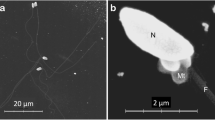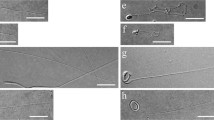Abstract
Spermatozoa from diploid and tetraploid Pacific oysters (Crassostrea gigas) were examined after anisotonic fixation. Morphological anomalies, such as membrane rupture, detached tails, and the formation of tail vesicles (typically associated with damage attributable to procedures such as cryopreservation) were observed; the Mantel-Haenszel Chi-square test indicated a strong association between the anomalies and fixative osmolality (P<0.001). The present study also indicated that media in a range of 800 to 1,086 mOsm/kg could be assumed to be functionally isotonic to Pacific oysters, and osmolalities below or above this caused severe cell damage. For example, the maximum volume of flagella obtained after hypotonic fixation was approximately twice the volume of the flagella in isotonic fixation. Sperm cell flagellar volumes after hypertonic fixation (1,110 mOsm/kg) were 32% smaller than those in isotonic fixation, and sperm heads were 25% smaller. Although the damage associated with anisotonic fixation was evident in all parts of the sperm cells, the most vulnerable locations were the plasma membrane and flagellum motor apparatus. The formation of tail vesicles after hypotonic fixation was also examined. Because of water uptake, oyster sperm became swollen in hypotonic fixative, and bending or coiling of the axoneme within the tail vesicles led to the appearance of multiple axonemal structures in cross sections when observed by transmission electron microscopy. This phenomenon might be generally misinterpreted as the presence of double tails. This and other fixation artifacts can lead to the misinterpretation of damage caused by cryopreservation in ultrastructure studies of sperm of aquatic species, especially those in marine species.




Similar content being viewed by others
References
Afzelius B (1959) Electron microscopy of the sperm tail—results obtained with a new fixative. J Biophys Biochem Cytol 5:269–278
Agresti A (1996) An introduction to categorical data analysis. Wiley, New York
Allen SK Jr (1983) Flow cytometry: assaying experimental polyploidy fish and shellfish. Aquaculture 33:317–328
Allen SK Jr, Bushek D (1992) Large-scale production of triploid oysters, Crassostrea virginica (Gmelin), using “stripped” gametes. Aquaculture 103:241–251
Billard R (1978) Changes in structure and fertilizing ability of marine and freshwater fish spermatozoa diluted in media of various salinities. Aquaculture 14:187–198
Billard R (1983) Ultrastructure of trout spermatozoa: changes after dilution and deep-freezing. Cell Tissue Res 228:205–218
Bredderman PJ, Foote RH (1969) Volume of stressed bull spermatozoa and protoplasmic droplets and the relationship of cell size to motility and fertility. J Anim Sci 28:496–501
Bury NR, Olive PJW (1993) Ultrastructural observations on membrane changes associated with cryopreserved spermatozoa of two polychaete species and subsequent mobility induced by quinacine. Inv Rep Dev 23:139–150
Conget P, Fernandez M, Herrera G, Minguell JJ (1996) Cryopreservation of rainbow trout (Oncorhynchus mykiss) spermatozoa using programmable freezing. Aquaculture 143:319–329
Dong Q (2005) Comparative studies of sperm cryopreservation of diploid and tetraploid Pacific oysters. Dissertation, Louisiana State University, Baton Rouge
Dong Q, Eudeline B, Allen JR, Tiersch TR (2002) Factors affecting sperm motility of tetraploid Pacific oysters. J Shellfish Res 21:719–723
Dong Q, Eudeline B, Huang C, Allen SK Jr, Tiersch TR (2005a) Commercial-scale sperm cryopreservation of diploid and tetraploid pacific oysters, Crassostrea gigas. Cryobiology 50:1–16
Dong Q, Huang C, Tiersch TR (2005b) Spermatozoal ultrastructure of diploid and tetraploid Pacific oysters. Aquaculture 249:487–496
Drevius L (1963) Spiralization in tails of mammalian spermatozoa in hypotonic media. Nature 197:1123–1124
Drevius L (1971) Permeability coefficients of bull spermatozoa for water and polyhydric alcohols. Exp Cell Res 69:212–216
Drevius L (1972a) Water content, specific gravity and concentrations of electrolytes in bull spermatozoa. J Reprod Fert 28:15–28
Drevius L (1972b) Bull spermatozoa as osmometers. J Reprod Fert 28:29–39
Drevius L (1972c) The permeability of bull spermatozoa to water, polyhydric alcohols and univalent anions and the effects of the anions upon the kinetic activity of spermatozoa and sperm models. J Reprod Fert 28:41–54
Drevius L (1972d) Induction of kinetic activity in immobile bull spermatozoa greatly swollen in hyposmotic media. Zoologica 53:31–39
Drevius L (1973) Permeability of the bull-sperm membrane. In: Afzelius BA (ed) The functional anatomy of the spermatozoon, Proceedings of the Second International Symposium, Wenner-Gren Center, Stockholm. Pergamon, New York, pp 373–383
Drevius L, Eriksson H (1966) Osmotic swelling of mammalian spermatozoa. Exp Cell Res 42:136–156
Eudeline B, Allen SK Jr, Guo X (2000) Delayed meiosis and polar body release in eggs of triploid Pacific oysters, Crassostrea gigas, in relation to tetraploid production. J Exp Mar Biol Ecol 248:151–161
Eudeline B, Allen SK Jr, Guo X (2002) Optimization of tetraploid induction in Pacific oysters, Crassostrea gigas, using first polar body as a natural indicator. Aquaculture 187:73–84
Foote RH, Bredderman PJ (1969) Sizing of aging bull spermatozoa with an electronic counter. J Dairy Sci 52:117–120
Garner DL, Johnson LA, Yue ST, Roth BL, Haugland RP (1994) Dual DNA staining assessment of bovine sperm viability using SYBR-14 and propidium iodile. J Androl 15:620–629
Graham JK, Kunze E, Hammerstedt RH (1990) Analysis of sperm cell viability, acrosomal integrity and mitochondrial function using flow cytometry. Bio Reprod 43:55–64
Guo X, Allen SK Jr (1994) Viable tetraploids in the Pacific oyster (Crassostrea gigas Thunberg) produced by inhibition of polar body I in eggs from triploids. Mol Mar Biol Biotechnol 3:42–50
Guo X, Debrosse G, Allen SK (1996) All-triploid Pacific oysters (Crassostrea gigas Thunberg) produced by mating tetraploids and diploids. Aquaculture 142:149–161
Gwo JC, Arnold CR (1992) Cryopreservation of Atlantic croaker spermatozoa: evaluation of morphological changes. J Exp Zool 264:444–453
He S, Woods LC III (2004) Changes in motility, ultrastructure, and fertilization capacity of striped bass Morone saxatilis spermatozoa following cryopreservation. Aquaculture 236:677–686
He Y, Dong Q, Tiersch TR, Devireddy RV (2004) Variation in the membrane transport properties and predicted optimal rates of freezing for spermatozoa of diploid and tetraploid Pacific oyster Crassostrea gigas. Biol Reprod 70:1428–1437
Jaspers EJ, Avault JW, Roussel JD (1976) Spermatozoal morphology and ultrastructure of channel catfish, Ictalurus punctatus. Trans Am Fish Soc 3:475–480
Ji XS, Chen SL, Tian YS, Yu GC, Sha ZX, Xu MY, Zhang SC (2004) Cryopreservation of sea perch (Lateolabrax japonicus) spermatozoa and feasibility for production-scale fertilization. Aquaculture 241:517–528
Karnovsky M (1965) A formaldehyde-glutaraldehyde fixative of high osmolality for use in electron microscopy. J Cell Biol 27:137A–138A
Ke Y, Cai N (1996) Cryopreservation of sperms from Penaeus chinensis (in Chinese). Oceanol Limnol Sin 27:187–193
Kölliker A (1856) Physiologische Studien über die Samenflussigkeit. Zeitschr Zool 2:1–20
Kurokura H, Namba K, Ishikawa T (1990) Lesions of spermatozoa by cryopreservation in oyster Crassostrea gigas. Nippon Suisan Gakkaishi 56:1803–1806
Lahnsteiner F, Weismann T, Patzner RA (1992) Fine structure changes in spermatozoa of the grayling, Thymallus thymallus (Pisces: Teleostei), during routine cryopreservation. Aquaculture 103:73–84
Lahnsteiner F, Berger B, Weismann T, Patzner RA (1996) Changes in morphology, physiology, metabolism, and fertilization capacity of rainbow trout semen following cryopreservation. Prog Fish-Cult 58:149–159
Leibo SP, Bradley L (1999) Comparative cryobiology of mammalian spermatozoa. In: Gagnon C (ed) The male gamete—from basic science to clinical applications. Cache River, Vienna, Ill., pp 501–516
Li Y, He G, Wang P (2002) The morphological and ultrastructural variation of Pacific oyster (Crassostrea gigas (Thunberg)) sperm after cryopreservation (in Chinese with English abstract). J Ocean Univ Qingdao 32:526–532
Lindahl PE, Drevius LO (1964) Observations of bull spermatozoa in a hypotonic medium related to sperm mobility mechanisms. Exp Cell Res 36:632–646
Maisse G (1996) Cryopreservation of fish semen, a review. Proceedings of the Conference of IIR commission C2. Refrigeration and Aquaculture. Bordeaux, France, pp 443–467
Mazur P (2004) Principles of cryobiology. In: Fuller BJ, Lane N, Benson EE (eds) Life in the frozen state. CRC, Boca Raton, pp 3–66
Paniagua-Chavez CG, Buchanam JT, Tiersch TR (1998) Effect of extender solutions and dilution on motility and fertilizing ability of eastern oyster sperm. J Shellfish Res 17:231–237
Quintero-Moreno AA, Rigau T, Rodriguez-Gil JE (2005) The hyperosmotic resistance test: a feasible parameter for boar spermatozoa function. Theriogenology 63:485–486
Rana K (1995) Preservation of gametes. In: Bromage NR, Roberts RJ (eds) Broodstock management and egg and larval quality. Cambridge University Press, Cambridge, pp 53–76
Reynolds ES (1963) The use of lead citrate at high pH as an electron-opaque stain in electron microscopy. J Cell Biol 17:208–212
Songsasen N, Leibo SP (1997) Cryopreservation of mouse spermatozoa. II. Relationship between survival after cryopreservation and osmotic tolerance of spermatozoa from three strains of mice. Cryobiology 35:255–269
Suquet M, Dreanno C, Fauvel C, Cosson J, Billard R (2000) Cryopreservation of sperm in marine fish. Aquacult Res 31:231–243
Taddei AR, Barbato F, Abelli L, Canese S, Moretti F, Rana KJ, Fausto AM, Mazzini M (2001) Is cryopreservation a homogenous process? Ultrastructure and motility of untreated, prefreezing, and postthawed spermatozoa of Diplodus puntazzo (Cetti). Cryobiology 42:244–255
Yao Z, Crim LW, Richardson GF, Emerson CJ (2000) Motility, fertility and ultrastructural changes of ocean pout (Macrozoarces americanus L.) sperm after cryopreservation. Aquaculture 181:361–375
Zhang X, Zhang L, Shen X (1991) Ultrastructure studies of cryopreserved fish sperm (in Chinese). Acta Sci Nat Univ Norm Hunan 14:160–163
Zhang YZ, Zhang SC, Liu XZ, Xu YY, Wang CL, Sawant MS, Li J, Chen SL (2003) Cryopreservation of flounder (Paralichthys olivaceus) sperm with a practical methodology. Theriogenology 60:989–996
Zhao WX, Jiang RL, Liu XY, Zhou SZ (1992) Observation on freezing damage of sperm and embryos from several Chinese carps by scanning electron microscope (in Chinese with English abstract). Freshw Fish 5:3–5
Acknowledgements
We thank B. Eudeline and Taylor Shellfish, for supplying the oysters, Y. Xiao and B. Liu for laboratory assistance, and R. Downer of the LSU Department of Experimental Statistics for statistical consultation. This manuscript was approved for publication by the Director of the Louisiana Agricultural Experiment Station (no. 05-11-0578).
Author information
Authors and Affiliations
Corresponding author
Additional information
This work was supported in part by funding from the USDA-SBIR program, 4Cs Breeding Technologies, and the Louisiana Sea Grant College Program.
Rights and permissions
About this article
Cite this article
Dong, Q., Huang, C., Henk, M.C. et al. Fixation methods can produce misleading artifacts in sperm cell ultrastructure of diploid and tetraploid Pacific oysters, Crassostrea gigas . Cell Tissue Res 324, 335–345 (2006). https://doi.org/10.1007/s00441-005-0141-9
Received:
Accepted:
Published:
Issue Date:
DOI: https://doi.org/10.1007/s00441-005-0141-9




